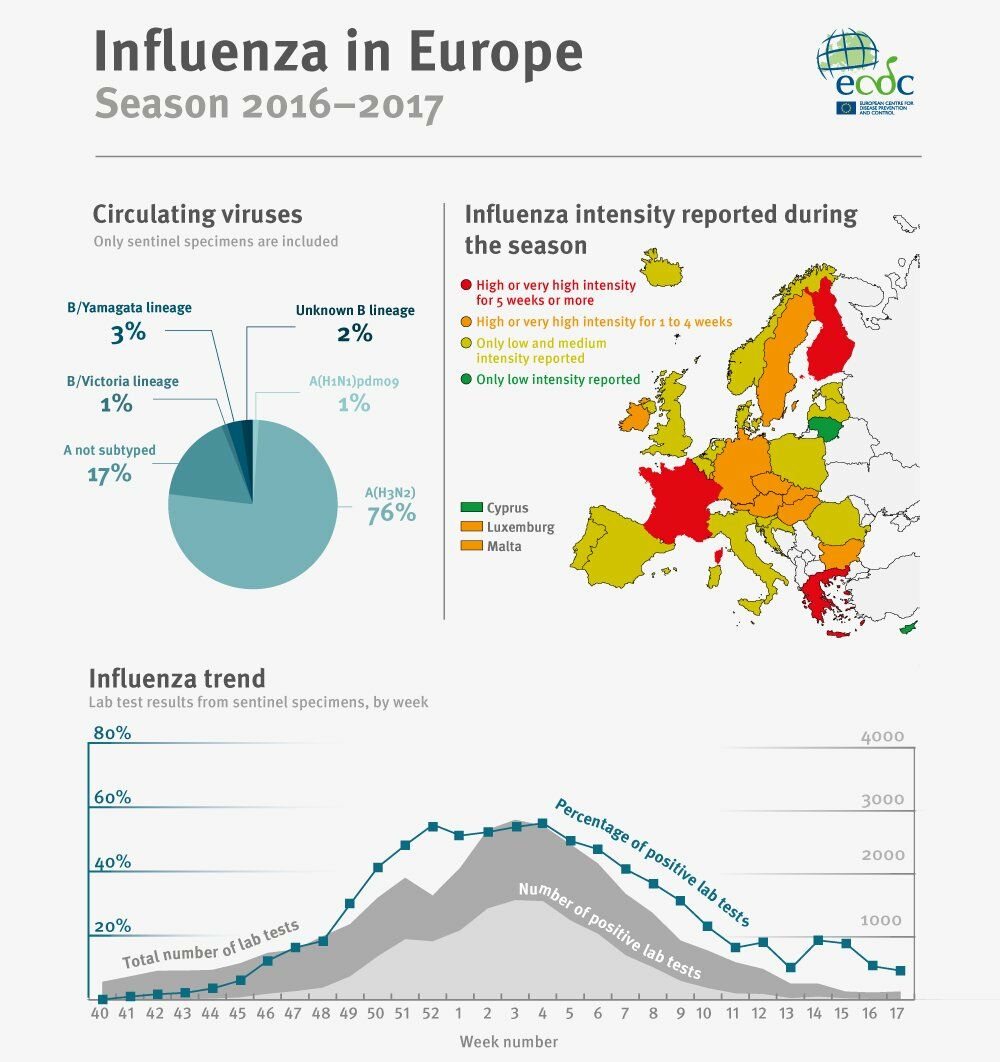Influenza in Europe, summary of the season 2016–17
Season's dynamics
The season started in EU/EEA countries in week 46/2016, the earliest start to the season in the past five years. As in the previous season, it was the Netherlands who first reported regional spread and medium intensity. The season lasted for 27 weeks, which is longer than recent past seasons (20–22 weeks).
The peak of the season, when the positivity rate exceeded 50% in the EU, occurred between weeks 52/2016 and 5/2017. For recent past seasons, the positivity rate exceeded 50% around 3–7 weeks after the start of the season (defined as positivity rate higher than 10%) and the >50% peak lasted 1–11 weeks.
Circulating viruses
Influenza A(H3N2) virus dominated, accounting for 76% of all sentinel specimens during the season. ECDC’s monitoring picked up signals that A(H3N2) was dominant as early as week 43. For intensive care unit admissions, A(H3N2) was the most commonly identified virus subtype and, as expected, given that A(H3N2) is known to affect older people more severely, about two-thirds of intensive care unit patients were over 65 years of age. This contrasts with the 2015–16 season where the predominant virus was A(H1N1)pdm09 and around 60% of influenza-related ICU admissions were 15–64 years.
Two-thirds of the A(H3N2) viruses genetically characterised belong to subclade 3C.2a1, although they remained antigenically similar to the clade 3C.2a vaccine virus. Preliminary estimates of influenza vaccine effectiveness for the 2016–2017 season show moderate effectiveness (38%) against A(H3N2) for all age groups, but suboptimal effectiveness (23.4%) for those over 65 years, although this is similar to other A(H3N2)-dominated seasons.
Increased all-cause mortality during the season
Data from the 17 countries or regions reporting to the European monitoring of excess mortality for public health action project (EuroMOMO) suggested a pattern of excess all-cause mortality among those over 65 years in the first weeks of 2017. The level of excess all-cause mortality was similar to the 2014–2015 winter season, which was also characterised by the dominance of A(H3N2), with an estimated 217 000 excess deaths.
Data on hospitalisations in reporting countries
In the nine EU countries reporting hospital data, 7 400 hospitalised cases of influenza were reported to ECDC this season, half of these being reported from intensive care units.
Flu News Europe
During the influenza season ECDC and WHO/Europe publish weekly data on Flu News Europe . Weekly online reporting for next season will start in week 40/2017. During the summer, weekly reporting to the European Surveillance System (TESSy) will continue, but bulletins will only be issued monthly on 30 May, 28 July, 1 September and 6 October 2017.




